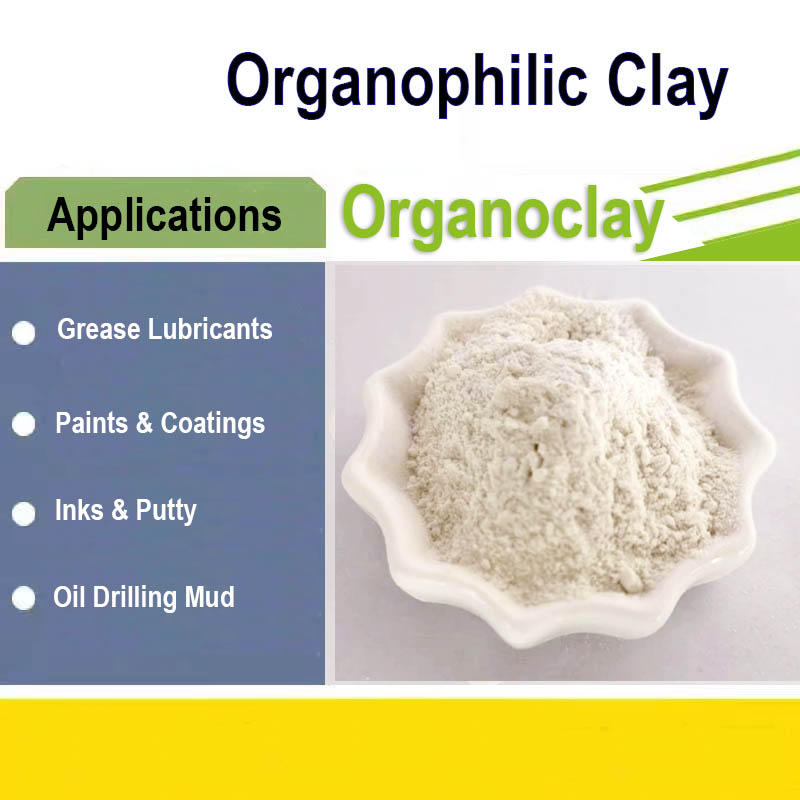Synthesis of Organoclays
Before jumping in the details of organoclay rheological additive, let’s first know how it is synthesized. The synthesis process involves modifying the surface of bentonite particles with organic compounds, typically quaternary ammonium salts. These organic compounds are carefully selected to ensure compatibility with the desired application and to achieve specific performance characteristics. The surface modification enhances the clay’s dispersibility in various matrices, such as polymers, coatings, drilling fluids, and other industrial formulations.
Its synthesis begins with the intercalation process, where the organic compounds are inserted between the layers of the montmorillonite or bentonite structure. This is typically achieved through ion exchange reactions, where the cations present in the clay lattice are replaced by the organic cations. The choice of organic cations depends on the desired properties of the organoclay Rheological Additive, such as the desired rheological behavior, compatibility with the host system, and temperature stability. The modified clay is subjected to additional processing steps, such as drying, grinding, and milling, to obtain a finely dispersed organoclay powder, which can be used as an organoclay rheological additive.
Surface Modification of Clay Minerals
Surface modification of clay minerals like bentonite is happening because of two reasons. One is physical adsorption, which involves the attachment of polymers onto the surface of clay minerals through non-covalent interactions. Polymers are typically dissolved or dispersed in a solvent and then mixed with bentonite clay minerals, allowing the polymer chains to adhere to the clay surfaces.
Chemical grafting involves covalently bonding functional polymers to the surfaces of bentonite clay minerals, forming a stronger and more permanent attachment. This approach often requires a chemical reaction between the clay surfaces and the polymer molecules.
The reaction can be achieved through methods such as esterification, amidation, or condensation reactions. Functional groups present on the polymer chains react with the surface hydroxyl groups of clay minerals, creating a covalent bond.
Surface modification of clay minerals through physical adsorption or chemical grafting of polymers creates organoclay rheological additives. These additives are the ones used in so many industry providing rheological capabilities to formulation of products.
Rheology Modifier (Organoclay Rheological Additive)
Rheology modifier can also be called as a rheological additive. These additives alter the rheological properties of materials. These are incorporated into formulations to increase viscosity and control the properties and characteristics of the finished product, commonly in oil field industries or paint, inks and coating manufacturing.
Rheology Modifier Bentonite Organoclay
Organoclay rheological additives that are based on bentonite clays have a lot of useful characteristics. It increases the viscosity of a formulation, making it thicker and more resistant to flow. They are commonly used in products such as paints, adhesives, coatings.
Organoclay rheological additives can also be used as a thixotropic modifier that can exhibit a decrease in viscosity under shear stress and a recovery of viscosity when the stress is removed. This behavior allows for easier application and spreading of a product while maintaining stability when at rest. It also helps prevent sagging or dripping of a formulation when applied vertically or on inclined surfaces. It also influences the flow behavior of a material, improving its leveling, wetting, or sprayability characteristics.
Rheological Properties of Palygorskite-Bentonite and Sepiolite-Bentonite Mixed Clay Suspensions
Sometimes, organoclay rheological additives are created by mixing clay minerals with bentonite clay. The combination of palygorskite or sepiolite with bentonite in clay suspensions results in enhanced rheological properties, including improved stability, controlled viscosity, sag resistance, and thixotropic behavior.
Palygorskite
Palygorskite is a fibrous clay mineral that has a unique crystal structure. It consists of long, thin, needle-like crystals that are intertwined, forming a three-dimensional network. This structure contributes to the distinctive properties of palygorskite clay.
The combination of palygorskite and smectite minerals possess the adsorption capabilities of palygorskite and the swelling and colloidal properties of smectite clays like bentonite. This combination results in attapulgite clays having excellent water absorption and retention properties, high surface area, and good dispersibility in water-based systems.
Sepiolite
Another fibrous clay mineral that is closely related to palygorskite. The significant advantages of sepiolite suspensions is their stability, even in systems with high salt content and high ionic strength. Unlike suspensions of other clays, such as bentonite, sepiolite suspensions maintain their stability and performance in challenging conditions. This stability is attributed to the unique structure and surface properties of sepiolite, which allow it to resist the effects of high salt concentrations and ionic interactions.
By mixing sepiolite with bentonite, a synergistic effect can be achieved, resulting in a superior product. Sepiolite enhances the properties of bentonite by providing additional stability, improved thixotropic behavior, and control over the rheological properties of the resulting mixture. The combination of sepiolite and bentonite creates a highly effective organoclay rheological additive.
Characterization of Anion–Cationic Surfactants Modified Montmorillonite
Cationic surfactants are substances that carry positive charges and can effectively be adsorbed onto materials that possess negative charges through strong electrostatic or charge-charge interactions. Montmorillonite is a type of clay mineral with a layered structure, consisting of stacked sheets. When montmorillonite is modified with cationic surfactants, the surfactant molecules are adsorbed onto the clay surface, altering its properties and enhancing its performance.
The modification of montmorillonite with cationic surfactants leads to the formation of organoclays rheological additive. This exhibit improved properties compared to the pristine clay used as a rheological additive. These modified clays are considered highly efficient absorbents due to their increased surface area, improved affinity for organic compounds, and enhanced adsorption capacity.
Rheology of Sodium and Calcium Bentonite-Water Dispersions
While both sodium and calcium bentonite dispersions exhibit thixotropic behavior, there is a notable difference in the degree of thixotropy between the two. Sodium bentonite typically shows a greater degree of thixotropy compared to calcium bentonite. The thixotropy exhibited by sodium bentonite can be two orders of magnitude higher than that of calcium bentonite.
The higher degree of thixotropy observed in sodium bentonite-water dispersions can be attributed to the unique properties of sodium ions. Sodium ions have a smaller size and a higher charge density compared to calcium ions. These properties allow sodium ions to form stronger electrostatic interactions with the clay particles, leading to increased structural rearrangement and shear thinning behavior.
Calcium bentonite-water dispersions still exhibit thixotropic behavior but to a lesser extent. The larger size and lower charge density of calcium ions result in weaker interactions with the clay particles, leading to lower levels of structural rearrangement and shear thinning.
Controlling Bentonite-Based Drilling Mud Properties
Controlling the properties of bentonite-based drilling mud is crucial for successful drilling operations. The addition of sepiolite nanoparticles to saline and fresh bentonite-based drilling mud can significantly improve the plastic viscosity and yield point. Plastic viscosity refers to the resistance to flow, while the yield point represents the minimum stress required to initiate flow. By enhancing these properties, sepiolite nanoparticles help maintain stable and controllable drilling mud flow.
A benefit of incorporating sepiolite nanoparticles is the improved stability of the drilling mud’s rheological properties across a wide range of temperature and pressure conditions. This is particularly crucial at high temperatures and pressures, where maintaining the desired flow characteristics becomes more challenging. Sepiolite nanoparticles help prevent undesirable changes in the mud’s rheological behavior, ensuring consistent performance during drilling operations.
Organoclay rheological additives with sepiolite nanoparticles have a positive impact on fluid loss reduction and permeability at reservoir pressure and temperatures. Fluid loss refers to the loss of drilling mud into the formation during drilling, which can lead to various issues such as formation damage and decreased drilling efficiency. Sepiolite nanoparticles effectively reduce fluid loss and minimize the permeability reduction, helping to maintain wellbore stability and drilling fluid integrity.
Effects of Carbon Ash on Rheological Properties of Water-Based Drilling Fluids
When carbon ash is introduced into bentonite dispersion, along with a commercial rheological modifier, notable changes occur in the rheological behavior of the drilling fluid. One of the prominent effects is the substantial improvement in yield point, particularly for low solid content bentonite dispersions.
The yield point of a drilling fluid represents the minimum stress required for the fluid to start flowing. By incorporating carbon ash into the bentonite dispersion, the yield point is noticeably enhanced, indicating improved fluid performance and stability. This enhancement becomes even more pronounced when the solid content of the bentonite dispersion is low.
In addition to the improved yield point, other rheological properties of the bentonite dispersion, such as plastic viscosity and gel strength, may also experience positive effects from the presence of carbon ash. These properties influence the fluid’s flow behavior and its ability to suspend and transport drilling cuttings.
Organoclay Rheological Additive Influence on High Pressure-High Temperature Volumetric Properties of Oil-Based Drilling Fluids
The influence of Organoclay Rheological Additive on the high pressure-high temperature volumetric properties of oil-based drilling fluids is of great importance in the oil and gas industry. Organoclay suspensions exhibit a density-temperature relationship similar to that of synthetic oil-based drilling fluids, making them suitable for use as rheological additives in such systems.
When organoclay is added as a rheological additive to the liquid matrix of oil-based drilling fluids, a significant increase in density values is observed across the entire range of temperature and pressure. This increase in density indicates that the organoclay enhances the overall density of the drilling fluid system. The densification effect is attributed to the incorporation of the organoclay particles and their interaction with the fluid matrix.
The expansive volumetric behavior of the organoclay suspensions is significantly influenced by the nature of the organoclay itself. Different types of organoclays can exhibit varying degrees of volumetric expansion. However, as the pressure increases, the expansive behavior is dampened. The increase in pressure acts to counterbalance the volumetric expansion, leading to a more controlled and stable system.


